Solar System: Top 5 Things To Know This Week
Solar System: Top 5 Things to Know This Week
Here are five things you need to know about our amazing solar system this week:
1. Perpetual Pluto-palooza

The New Horizons spacecraft continues its ongoing download of data and images from the July 14 flyby of the Pluto system. In the latest weekly release, the new images don’t disappoint, showing fine details in an exotic landscape. The New Horizons team has also described a wide range of findings about the dwarf planet’s system in its first science paper. Learn more HERE.
2. Encounter at Enceladus

The Cassini spacecraft has returned the closest images ever showing the north polar region of Saturn’s intriguing ice moon Enceladus. Scientists expected the area to be heavily cratered, but the new high-resolution Cassini images also show a landscape of stark contrasts, crisscrossed by a spidery network of gossamer-thin cracks that slice through the craters. The robotic spacecraft buzzed by the moon during the first of what will be three close encounters this year -- the last of the long mission. Next up: on Oct. 28 Cassini will deep dive right through Enceladus’ famous ice geyser plume! Learn more HERE.
3. We’re Giving You the Whole World, Every Day
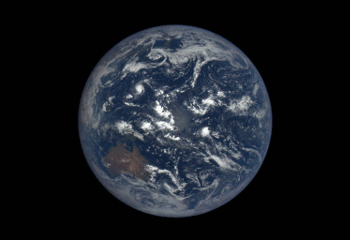
We have worked with NOAA to launch a new website that shows the full, sunlit side of the Earth on a daily basis. The images come from our camera a million miles away aboard the Deep Space Climate Observatory (DSCOVR). Each daily sequence of images shows the Earth as it rotates, revealing the entire planet over the course of a day. Take a look HERE.
4. Going Big at Jupiter

We have large, new maps of Jupiter, thanks to data from the Wide Field Camera 3 on our Hubble Space Telescope. The big images provide a detailed look at how the giant planet’s features change over time. In fact, the maps are just the first in a planned series of yearly portraits of the solar system’s four outer planets. The views come as we prepare for the Juno mission to arrive at Jupiter in little less than a year.
5. Catch a Falling Star

Meteors aren’t really falling stars, just dust and rock from deep space meeting a fiery end in Earth’s atmosphere -- but they’re a sight to behold if you can catch a glimpse. The Orionid meteors appear every year around this time, when Earth travels through an area of space littered with debris from Halley’s Comet. This year the peak will occur on the night of Wednesday, Oct. 21, into the morning of Thursday, Oct. 22. Find out how to watch HERE.
Make sure to follow us on Tumblr for your regular dose of space: http://nasa.tumblr.com
More Posts from Nasa and Others
Happy International Women’s Day!

Today we celebrate International Women’s Day, a day in which we honor and recognize the contributions of women…both on Earth and in space.

Since the beginning, women have been essential to the progression and success of America’s space program.

Throughout history, women have had to overcome struggles in the workplace. The victories for gender rights were not achieved easily or quickly, and our work is not done.

Today, we strive to make sure that our legacy of inclusion and excellence lives on.

We have a long-standing cultural commitment to excellence that is largely driven by data, including data about our people. And our data shows progress is driven by questioning our assumptions and cultural prejudices – by embracing and nurturing all talent we have available, regardless of gender, race or other protected status, to build a workforce as diverse as our mission. This is how we, as a nation, will take the next giant leap in exploration.

As a world leader in science, aeronautics, space exploration and technology, we have a diverse mission that demands talent from every corner of America, and every walk of life.

So, join us today, and every day, as we continue our legacy of inclusion and excellence.

Happy International Women’s Day!
Learn more about the inspiring woman at NASA here: https://women.nasa.gov/

Our newest class of astronaut candidates graduated on March 5, 2024. This means they’re now eligible for spaceflight assignments to the International Space Station, the Moon, and beyond! In the next twelve posts, we’ll introduce these new astronauts.
Do you want to be a NASA astronaut? Applications are now open.
Make sure to follow us on Tumblr for your regular dose of space!
What’s Up for December?

View Mars right now, and prepare for 2016, the best Mars viewing year since 2005! Last month early risers watched small, reddish Mars dance with brighter Jupiter and Venus just before sunrise.

This month Mars rises earlier-by about 2 a.m. local time. Its reddish color is unmistakable, even without a telescope. It's easy to see below the Moon and Jupiter on December 4. You won't see many features this month, because the planet is almost 10 times smaller than nearby Jupiter appears and 350 times smaller than the Moon appears to us on Earth.

You should also be able to see Mars' north polar region this month, because it's currently tilted towards Earth.

You'll be amazed at the changes you'll see during 2016. January through December are all prime Mars observing months. Between January and May next year, Mars triples in apparent diameter as its orbit around the sun brings it closer to Earth. You'll even be able to see the areas on Mars where NASA's Mars landers are located.

By October, Mars shrinks in apparent size to less than half its May diameter as it speeds away from Earth. Mars shrinks even further from October through December, returning to the same size we saw in January 2016 by year's end.
So put Mars viewing on your calendar for 2016. You won't see Mars this size again until 2018, when Mars will put on an even better show.

Make sure to follow us on Tumblr for your regular dose of space: http://nasa.tumblr.com
What’s Up for November 2016
What’s Up for November: Venus at sunset, Jupiter at dawn, your last evening glimpse of Saturn until spring, and more meteors!

Through November 3, catch glimpses of a gibbous Venus, a crescent moon and ringed Saturn in the southwest sky just after sunset.

Wake up before sunrise every day this month to see Jupiter just above Spica, the brightest star in the constellation Virgo, shining in the east-southeast sky.
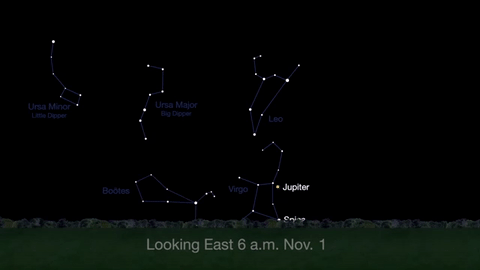
Just before dawn on November 23-24, see the waning crescent moon just above Jupiter.
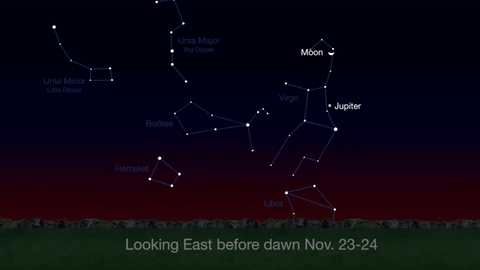
November is a great time to see the constellation Ceres as it glides past Cetus, the Whale and you will be able to see the dwarf planet move relative to the background stars, but you’ll need a telescope for this one.
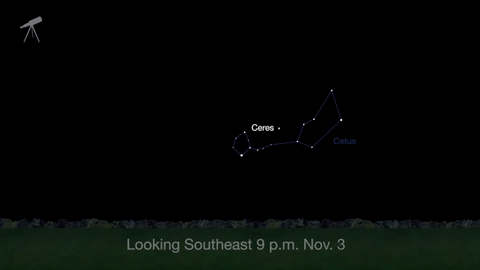
This month, just like last month, there will be three meteor showers--the Northern Tuarids, the Leonids and the November Orionids.
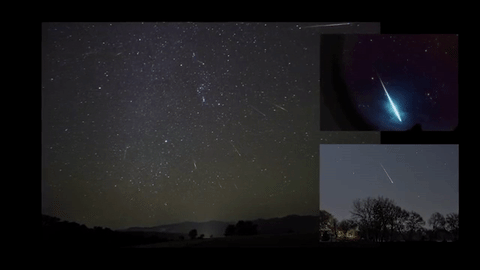
Watch the full November “What’s Up" video for more:
Make sure to follow us on Tumblr for your regular dose of space: http://nasa.tumblr.com.
It's the International Day of Human Space Flight!

In this image, NASA astronaut Sunita Williams, Expedition 32 flight engineer, appears to touch the bright Sun during the mission's third spacewalk outside the International Space Station. Japan Aerospace Exploration Agency astronaut Aki Hoshide is visible in the reflection of Williams' helmet visor.
Today, April 12, is the International Day of Human Space Flight—marking Yuri Gagarin's first flight in 1961, and the first space shuttle launch in 1981.
As we honor global collaboration in exploration, we're moving forward to the Moon & Mars under the Artemis Accords.
Sign up to send your name around the Moon aboard Artemis I at go.nasa.gov/wearegoing.
The Five W’s of an Expandable Habitat in Space
Who: In this case, it's really a “what.” The Bigelow Expandable Activity Module (BEAM) is an expandable module developed by Bigelow Aerospace using a NASA patent conceptualized in the 1990s. It is made up of layers of fabric that will expand when installed and equalize with the pressure of the International Space Station.

What: Sensors inside BEAM will monitor temperature and radiation changes, as well as its resistance to potential orbital debris impacts. During its time on station, the airlock between BEAM and the rest of the space station will remained closed, and astronauts will enter only to collect data and help the experiment progress. If BEAM is punctured, the habitat is designed to slowly compress to keep the rest of the space station safe.
With the BEAM launch, deployment and time on station, Bigelow will demonstrate a number of expandable habitat capabilities, such as its folding and packing techniques, radiation protection capability and its thermal, structural and mechanical durability.

When: BEAM is set to launch on SpaceX's eighth Dragon resupply mission April 8, and will be docked to the space station for a minimum two-year demonstration period.
Where: The International Space Station’s mechanical arm will transport BEAM from the spacecraft to a berthing port on the Tranquility module where it will then be expanded.

Why: These expandable modules take up less room on a rocket, but once set up, provide more volume for living and working in space.

When we’re traveling to Mars or beyond, astronauts need habitats that are both durable and easy to transport and to set up. That’s where expandable technology comes in. BEAM is one of the first steps to test expandable structures as a viable alternative to traditional space habitats.
Make sure to follow us on Tumblr for your regular dose of space: http://nasa.tumblr.com
Gelatin in space! Looks a bit like a tadpole when it is floating around, but I promise it was a tasty treat for us on the Space Station. The food lab prepared drink bags with gelatin mix inside, and I made gelatin for the crew. It is very tempting to play with your food when it floats.
Solar System: Things to Know This Week
Ready for a free show? Here’s our guide to the brightest shows on Earth for 2017--meteor showers! And, there’s no telescope required.
The sky may not be falling, but it can certainly seem that way during a meteor shower. Shooting stars, as meteors are sometimes called occur when rock and debris in space fall through the Earth's atmosphere, leaving a bright trail as they are heated to incandescence by friction with the air. Sometimes the number of meteors in the sky increases dramatically, becoming meteor showers. Some showers occur annually or at regular intervals as the Earth passes through the trail of dusty debris left by a comet. Here's a guide to the top meteor showers expected in 2017.

1. Quadrantids, January 3-4
At its peak this shower will have about 40 meteors per hour. The parent comet is 2003 EH1, which was discovered in 2003. First quarter moon sets after midnight and meteors radiate from the constellation Bootes.

2. Eta Aquarids, May 6-7
This shower will have up to 60 meteors per hour at its peak and is produced by dust particles left behind by comet Halley, which has been known and observed since ancient times. The shower runs annually from April 19 to May 28. The waxing gibbous moon will block out many of the fainter meteors this year. Meteors will radiate from the constellation Aquarius.

3. Perseids, August 12-13
The annual Perseid shower will have up to 60 meteors per hour at its peak. It is produced by comet Swift-Tuttle. The Perseids are famous for producing a large number of bright meteors. The shower runs annually from July 17 to August 24. The waning gibbous moon will block out many of the fainter meteors this year, but the Perseids are so bright and numerous that it should still be a good show. Meteors will radiate from the constellation Perseus.

4. Draconids, October 7
This is a minor shower that will produce only about 10 meteors per hour. It is produced by dust grains left behind by comet 21P Giacobini-Zinner, which was first discovered in 1900. The Draconids is an unusual shower in that the best viewing is in the early evening instead of early morning like most other showers. The shower runs annually from October 6-10 and peaks this year on the the night of the 7th. Unfortunately, the nearly full moon will block all but the brightest meteors this year. If you are extremely patient, you may be able to catch a few good ones. Meteors will radiate from the constellation Draco.

5. Geminids, December 13-14
The Geminids may be the best shower, producing up to 120 meteors per hour at its peak. It is produced by debris left behind by an asteroid known as 3200 Phaethon, which was discovered in 1982. The shower runs annually from December 7-17. The waning crescent moon will be no match for the Geminids this year. The skies should still be dark enough for an excellent show. Meteors will radiate from the constellation Gemini, but can appear anywhere in the sky.
Discover the full list of 10 things to know about our solar system this week HERE.
Make sure to follow us on Tumblr for your regular dose of space: http://nasa.tumblr.com
New Science from our Mission to Touch the Sun

In August 2018, our Parker Solar Probe mission launched to space, soon becoming the closest-ever spacecraft from the Sun. Now, scientists have announced their first discoveries from this exploration of our star!
The Sun may look calm to us here on Earth, but it's an active star, unleashing powerful bursts of light, deluges of particles moving near the speed of light and billion-ton clouds of magnetized material. All of this activity can affect our technology here on Earth and in space.
Parker Solar Probe's main science goals are to understand the physics that drive this activity — and its up-close look has given us a brand-new perspective. Here are a few highlights from what we've learned so far.
1. Surprising events in the solar wind
The Sun releases a continual outflow of magnetized material called the solar wind, which shapes space weather near Earth. Observed near Earth, the solar wind is a relatively uniform flow of plasma, with occasional turbulent tumbles. Closer to the solar wind's source, Parker Solar Probe saw a much different picture: a complicated, active system.
One type of event in particular drew the eye of the science teams: flips in the direction of the magnetic field, which flows out from the Sun, embedded in the solar wind. These reversals — dubbed "switchbacks" — last anywhere from a few seconds to several minutes as they flow over Parker Solar Probe. During a switchback, the magnetic field whips back on itself until it is pointed almost directly back at the Sun.

The exact source of the switchbacks isn't yet understood, but Parker Solar Probe's measurements have allowed scientists to narrow down the possibilities — and observations from the mission's 21 remaining solar flybys should help scientists better understand these events.
2. Seeing tiny particle events
The Sun can accelerate tiny electrons and ions into storms of energetic particles that rocket through the solar system at nearly the speed of light. These particles carry a lot of energy, so they can damage spacecraft electronics and even endanger astronauts, especially those in deep space, outside the protection of Earth's magnetic field — and the short warning time for such particles makes them difficult to avoid.

Energetic particles from the Sun impact a detector on ESA & NASA's SOHO satellite.
Parker Solar Probe's energetic particle instruments have measured several never-before-seen events so small that all trace of them is lost before they reach Earth. These instruments have also measured a rare type of particle burst with a particularly high number of heavier elements — suggesting that both types of events may be more common than scientists previously thought.
3. Rotation of the solar wind
Near Earth, we see the solar wind flowing almost straight out from the Sun in all directions. But the Sun rotates as it releases the solar wind, and before it breaks free, the wind spins along in sync with the Sun's surface. For the first time, Parker was able to observe the solar wind while it was still rotating – starting more than 20 million miles from the Sun.

The strength of the circulation was stronger than many scientists had predicted, but it also transitioned more quickly than predicted to an outward flow, which helps mask the effects of that fast rotation from the vantage point where we usually see them from, near Earth, about 93 million miles away. Understanding this transition point in the solar wind is key to helping us understand how the Sun sheds energy, with implications for the lifecycles of stars and the formation of protoplanetary disks.
4. Hints of a dust-free zone
Parker also saw the first direct evidence of dust starting to thin out near the Sun – an effect that has been theorized for nearly a century, but has been impossible to measure until now. Space is awash in dust, the cosmic crumbs of collisions that formed planets, asteroids, comets and other celestial bodies billions of years ago. Scientists have long suspected that, close to the Sun, this dust would be heated to high temperatures by powerful sunlight, turning it into a gas and creating a dust-free region around the Sun.

For the first time, Parker's imagers saw the cosmic dust begin to thin out a little over 7 million miles from the Sun. This decrease in dust continues steadily to the current limits of Parker Solar Probe's instruments, measurements at a little over 4 million miles from the Sun. At that rate of thinning, scientists expect to see a truly dust-free zone starting a little more than 2-3 million miles from the Sun — meaning the spacecraft could observe the dust-free zone as early as 2020, when its sixth flyby of the Sun will carry it closer to our star than ever before.
These are just a few of Parker Solar Probe's first discoveries, and there's plenty more science to come throughout the mission! For the latest on our Sun, follow @NASASun on Twitter and NASA Sun Science on Facebook.
Spooky Sounds from Across the Solar System
Soaring to the depths of our universe, gallant spacecraft roam the cosmos, snapping images of celestial wonders. Some spacecraft have instruments capable of capturing radio emissions. When scientists convert these to sound waves, the results are eerie to hear.
In time for Halloween, we've put together a compilation of elusive "sounds" of howling planets and whistling helium that is sure to make your skin crawl.
Listen to a few here and visit our Soundcloud for more spooky sounds.
Cassini Ring Crossing
This eerie audio represents data collected by our Cassini spacecraft, as it crossed through the gap between Saturn and its rings on April 26, 2017, during the first dive of the mission's Grand Finale. The instrument is able to record ring particles striking the spacecraft in its data. In the data from this dive, there is virtually no detectable peak in pops and cracks that represent ring particles striking the spacecraft. The lack of discernible pops and cracks indicates the region is largely free of small particles.
Voyager Tsunami Waves in Interstellar Space
Listen to this howling audio from our Voyager 1 spacecraft. Voyager 1 has experienced three "tsunami waves" in interstellar space. This kind of wave occurs as a result of a coronal mass ejection erupting from the Sun. The most recent tsunami wave that Voyager experienced began in February 2014, and may still be going. Listen to how these waves cause surrounding ionized matter to ring like a bell.
Voyager Sounds of Interstellar Space
Our Voyager 1 spacecraft captured these high-pitched, spooky sounds of interstellar space from October to November 2012 and April to May 2013.
The soundtrack reproduces the amplitude and frequency of the plasma waves as "heard" by Voyager 1. The waves detected by the instrument antennas can be simply amplified and played through a speaker. These frequencies are within the range heard by human ears.
When scientists extrapolated this line even further back in time (not shown), they deduced that Voyager 1 first encountered interstellar plasma in August 2012.
Plasma Sounds at Jupiter
Ominous sounds of plasma! Our Juno spacecraft has observed plasma wave signals from Jupiter’s ionosphere. The results in this video show an increasing plasma density as Juno descended into Jupiter’s ionosphere during its close pass by Jupiter on February 2, 2017.
Roar of Jupiter
Juno's Waves instrument recorded this supernatural sounding encounter with the bow shock over the course of about two hours on June 24, 2016. "Bow shock" is where the supersonic solar wind is heated and slowed by Jupiter's magnetosphere. It is analogous to a sonic boom on Earth. The next day, June 25, 2016, the Waves instrument witnessed the crossing of the magnetopause. "Trapped continuum radiation" refers to waves trapped in a low-density cavity in Jupiter's magnetosphere.
Visit the NASA Soundcloud for more spooky space sounds: https://soundcloud.com/nasa/sets/spookyspacesounds
Make sure to follow us on Tumblr for your regular dose of space: http://nasa.tumblr.com.
-
 quepulmaitucon liked this · 1 year ago
quepulmaitucon liked this · 1 year ago -
 tt-squid liked this · 3 years ago
tt-squid liked this · 3 years ago -
 ageorgebir liked this · 8 years ago
ageorgebir liked this · 8 years ago -
 trick-or-triche liked this · 8 years ago
trick-or-triche liked this · 8 years ago -
 throneofskyrim-blog liked this · 8 years ago
throneofskyrim-blog liked this · 8 years ago -
 quietkiddo-with-a-soft-heart liked this · 8 years ago
quietkiddo-with-a-soft-heart liked this · 8 years ago -
 narconautic reblogged this · 8 years ago
narconautic reblogged this · 8 years ago -
 blue-sialia liked this · 8 years ago
blue-sialia liked this · 8 years ago -
 armies-of-hell liked this · 8 years ago
armies-of-hell liked this · 8 years ago -
 sunflower-galaxy-m63 reblogged this · 9 years ago
sunflower-galaxy-m63 reblogged this · 9 years ago -
 sunflower-galaxy-m63 liked this · 9 years ago
sunflower-galaxy-m63 liked this · 9 years ago -
 megaradcollectionwolfthings-blog liked this · 9 years ago
megaradcollectionwolfthings-blog liked this · 9 years ago -
 th95s liked this · 9 years ago
th95s liked this · 9 years ago -
 kelly-clickspring liked this · 9 years ago
kelly-clickspring liked this · 9 years ago -
 deity-of-keys reblogged this · 9 years ago
deity-of-keys reblogged this · 9 years ago -
 deity-of-keys liked this · 9 years ago
deity-of-keys liked this · 9 years ago -
 sekineasato liked this · 9 years ago
sekineasato liked this · 9 years ago -
 littlebuters reblogged this · 9 years ago
littlebuters reblogged this · 9 years ago -
 littlebuters liked this · 9 years ago
littlebuters liked this · 9 years ago -
 im-gonna-run-the-world liked this · 9 years ago
im-gonna-run-the-world liked this · 9 years ago -
 andishouldhavekissedyou reblogged this · 9 years ago
andishouldhavekissedyou reblogged this · 9 years ago -
 tinkerbell922 liked this · 9 years ago
tinkerbell922 liked this · 9 years ago -
 astro-dolly reblogged this · 9 years ago
astro-dolly reblogged this · 9 years ago -
 oh-deeeeer liked this · 9 years ago
oh-deeeeer liked this · 9 years ago -
 ad-cn reblogged this · 9 years ago
ad-cn reblogged this · 9 years ago -
 tristanshoard reblogged this · 9 years ago
tristanshoard reblogged this · 9 years ago
Explore the universe and discover our home planet with the official NASA Tumblr account
1K posts